Strategic Management for Coca-Cola's Diet Coke
VerifiedAdded on 2023/04/25
|10
|2819
|359
AI Summary
This report discusses the strategic management plan for Coca-Cola's Diet Coke, including brand identity, product design, and specific strategies for content and social media marketing. It also covers the selection of product, strategic position plan, and advertisements.
Contribute Materials
Your contribution can guide someone’s learning journey. Share your
documents today.
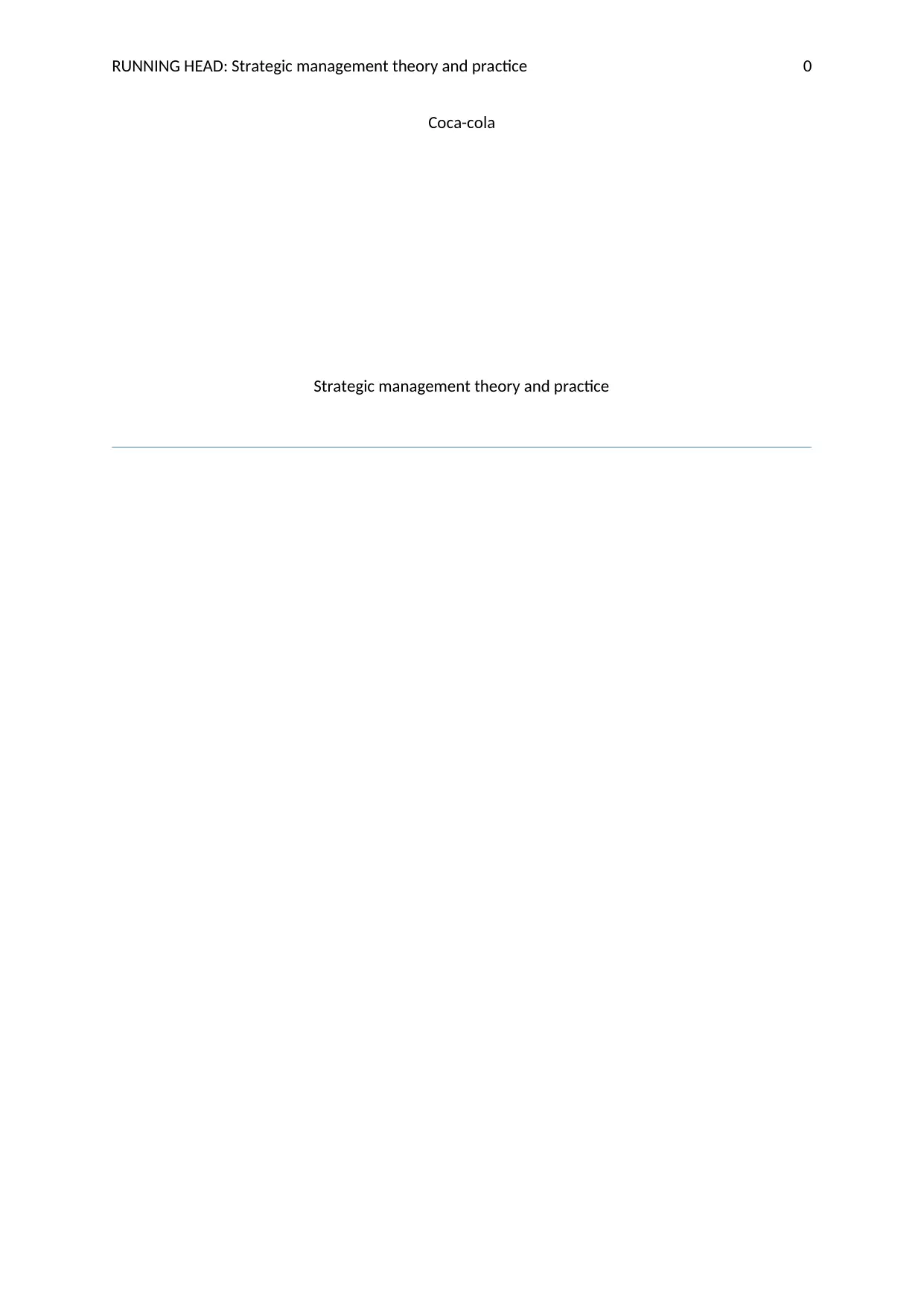
RUNNING HEAD: Strategic management theory and practice 0
Coca-cola
Strategic management theory and practice
Coca-cola
Strategic management theory and practice
Secure Best Marks with AI Grader
Need help grading? Try our AI Grader for instant feedback on your assignments.
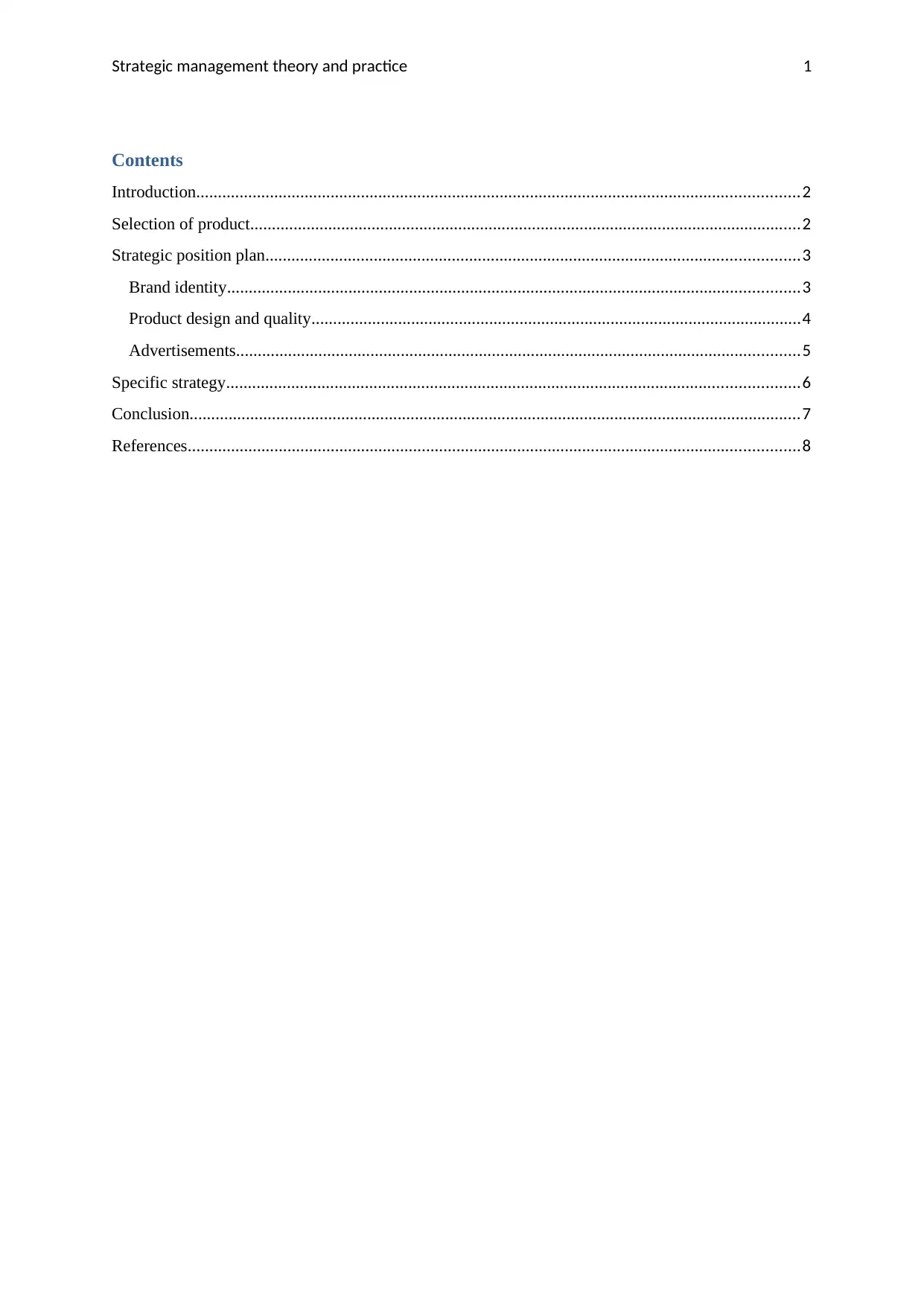
Strategic management theory and practice 1
Contents
Introduction...........................................................................................................................................2
Selection of product...............................................................................................................................2
Strategic position plan...........................................................................................................................3
Brand identity....................................................................................................................................3
Product design and quality.................................................................................................................4
Advertisements..................................................................................................................................5
Specific strategy....................................................................................................................................6
Conclusion.............................................................................................................................................7
References.............................................................................................................................................8
Contents
Introduction...........................................................................................................................................2
Selection of product...............................................................................................................................2
Strategic position plan...........................................................................................................................3
Brand identity....................................................................................................................................3
Product design and quality.................................................................................................................4
Advertisements..................................................................................................................................5
Specific strategy....................................................................................................................................6
Conclusion.............................................................................................................................................7
References.............................................................................................................................................8
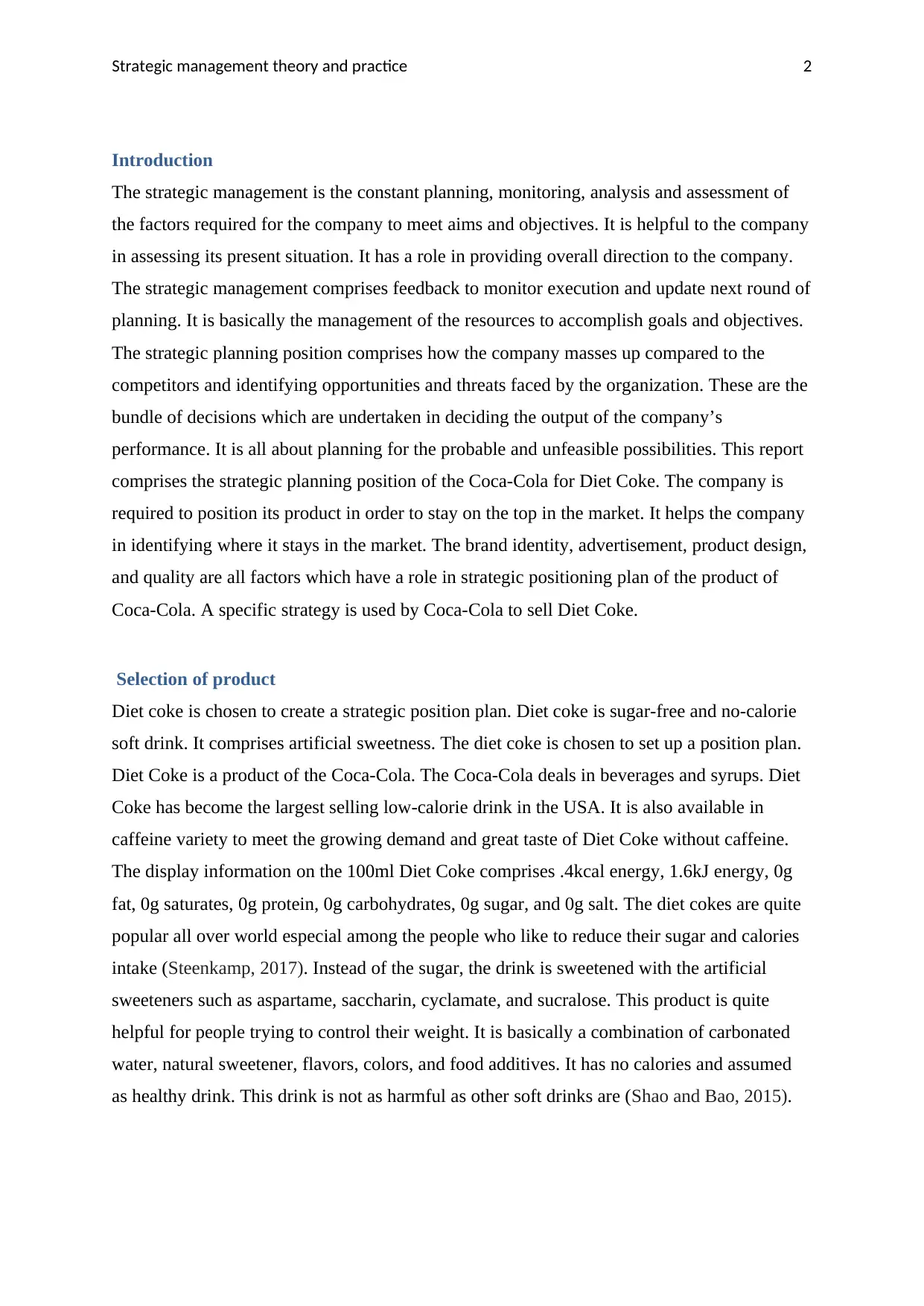
Strategic management theory and practice 2
Introduction
The strategic management is the constant planning, monitoring, analysis and assessment of
the factors required for the company to meet aims and objectives. It is helpful to the company
in assessing its present situation. It has a role in providing overall direction to the company.
The strategic management comprises feedback to monitor execution and update next round of
planning. It is basically the management of the resources to accomplish goals and objectives.
The strategic planning position comprises how the company masses up compared to the
competitors and identifying opportunities and threats faced by the organization. These are the
bundle of decisions which are undertaken in deciding the output of the company’s
performance. It is all about planning for the probable and unfeasible possibilities. This report
comprises the strategic planning position of the Coca-Cola for Diet Coke. The company is
required to position its product in order to stay on the top in the market. It helps the company
in identifying where it stays in the market. The brand identity, advertisement, product design,
and quality are all factors which have a role in strategic positioning plan of the product of
Coca-Cola. A specific strategy is used by Coca-Cola to sell Diet Coke.
Selection of product
Diet coke is chosen to create a strategic position plan. Diet coke is sugar-free and no-calorie
soft drink. It comprises artificial sweetness. The diet coke is chosen to set up a position plan.
Diet Coke is a product of the Coca-Cola. The Coca-Cola deals in beverages and syrups. Diet
Coke has become the largest selling low-calorie drink in the USA. It is also available in
caffeine variety to meet the growing demand and great taste of Diet Coke without caffeine.
The display information on the 100ml Diet Coke comprises .4kcal energy, 1.6kJ energy, 0g
fat, 0g saturates, 0g protein, 0g carbohydrates, 0g sugar, and 0g salt. The diet cokes are quite
popular all over world especial among the people who like to reduce their sugar and calories
intake (Steenkamp, 2017). Instead of the sugar, the drink is sweetened with the artificial
sweeteners such as aspartame, saccharin, cyclamate, and sucralose. This product is quite
helpful for people trying to control their weight. It is basically a combination of carbonated
water, natural sweetener, flavors, colors, and food additives. It has no calories and assumed
as healthy drink. This drink is not as harmful as other soft drinks are (Shao and Bao, 2015).
Introduction
The strategic management is the constant planning, monitoring, analysis and assessment of
the factors required for the company to meet aims and objectives. It is helpful to the company
in assessing its present situation. It has a role in providing overall direction to the company.
The strategic management comprises feedback to monitor execution and update next round of
planning. It is basically the management of the resources to accomplish goals and objectives.
The strategic planning position comprises how the company masses up compared to the
competitors and identifying opportunities and threats faced by the organization. These are the
bundle of decisions which are undertaken in deciding the output of the company’s
performance. It is all about planning for the probable and unfeasible possibilities. This report
comprises the strategic planning position of the Coca-Cola for Diet Coke. The company is
required to position its product in order to stay on the top in the market. It helps the company
in identifying where it stays in the market. The brand identity, advertisement, product design,
and quality are all factors which have a role in strategic positioning plan of the product of
Coca-Cola. A specific strategy is used by Coca-Cola to sell Diet Coke.
Selection of product
Diet coke is chosen to create a strategic position plan. Diet coke is sugar-free and no-calorie
soft drink. It comprises artificial sweetness. The diet coke is chosen to set up a position plan.
Diet Coke is a product of the Coca-Cola. The Coca-Cola deals in beverages and syrups. Diet
Coke has become the largest selling low-calorie drink in the USA. It is also available in
caffeine variety to meet the growing demand and great taste of Diet Coke without caffeine.
The display information on the 100ml Diet Coke comprises .4kcal energy, 1.6kJ energy, 0g
fat, 0g saturates, 0g protein, 0g carbohydrates, 0g sugar, and 0g salt. The diet cokes are quite
popular all over world especial among the people who like to reduce their sugar and calories
intake (Steenkamp, 2017). Instead of the sugar, the drink is sweetened with the artificial
sweeteners such as aspartame, saccharin, cyclamate, and sucralose. This product is quite
helpful for people trying to control their weight. It is basically a combination of carbonated
water, natural sweetener, flavors, colors, and food additives. It has no calories and assumed
as healthy drink. This drink is not as harmful as other soft drinks are (Shao and Bao, 2015).
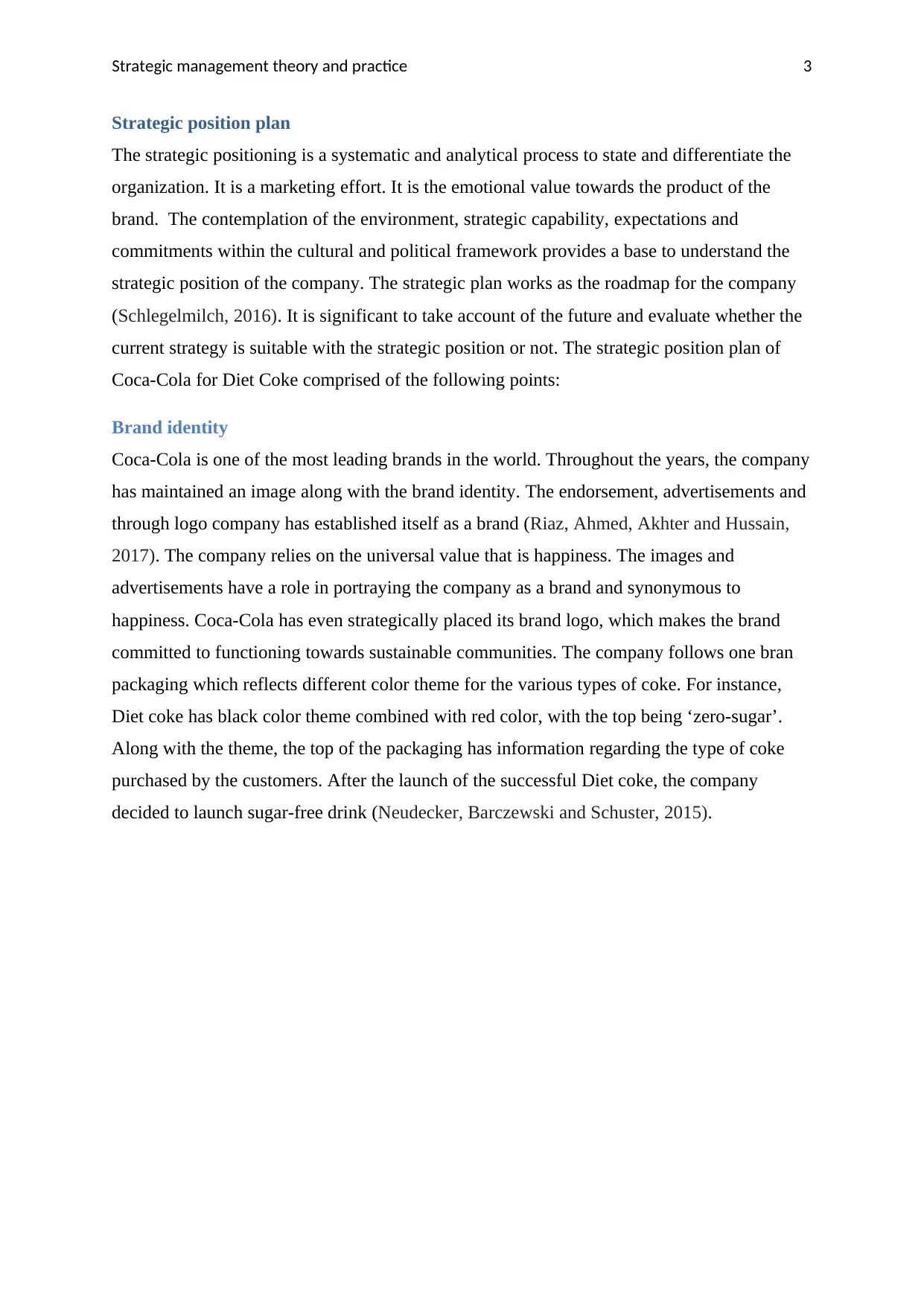
Strategic management theory and practice 3
Strategic position plan
The strategic positioning is a systematic and analytical process to state and differentiate the
organization. It is a marketing effort. It is the emotional value towards the product of the
brand. The contemplation of the environment, strategic capability, expectations and
commitments within the cultural and political framework provides a base to understand the
strategic position of the company. The strategic plan works as the roadmap for the company
(Schlegelmilch, 2016). It is significant to take account of the future and evaluate whether the
current strategy is suitable with the strategic position or not. The strategic position plan of
Coca-Cola for Diet Coke comprised of the following points:
Brand identity
Coca-Cola is one of the most leading brands in the world. Throughout the years, the company
has maintained an image along with the brand identity. The endorsement, advertisements and
through logo company has established itself as a brand (Riaz, Ahmed, Akhter and Hussain,
2017). The company relies on the universal value that is happiness. The images and
advertisements have a role in portraying the company as a brand and synonymous to
happiness. Coca-Cola has even strategically placed its brand logo, which makes the brand
committed to functioning towards sustainable communities. The company follows one bran
packaging which reflects different color theme for the various types of coke. For instance,
Diet coke has black color theme combined with red color, with the top being ‘zero-sugar’.
Along with the theme, the top of the packaging has information regarding the type of coke
purchased by the customers. After the launch of the successful Diet coke, the company
decided to launch sugar-free drink (Neudecker, Barczewski and Schuster, 2015).
Strategic position plan
The strategic positioning is a systematic and analytical process to state and differentiate the
organization. It is a marketing effort. It is the emotional value towards the product of the
brand. The contemplation of the environment, strategic capability, expectations and
commitments within the cultural and political framework provides a base to understand the
strategic position of the company. The strategic plan works as the roadmap for the company
(Schlegelmilch, 2016). It is significant to take account of the future and evaluate whether the
current strategy is suitable with the strategic position or not. The strategic position plan of
Coca-Cola for Diet Coke comprised of the following points:
Brand identity
Coca-Cola is one of the most leading brands in the world. Throughout the years, the company
has maintained an image along with the brand identity. The endorsement, advertisements and
through logo company has established itself as a brand (Riaz, Ahmed, Akhter and Hussain,
2017). The company relies on the universal value that is happiness. The images and
advertisements have a role in portraying the company as a brand and synonymous to
happiness. Coca-Cola has even strategically placed its brand logo, which makes the brand
committed to functioning towards sustainable communities. The company follows one bran
packaging which reflects different color theme for the various types of coke. For instance,
Diet coke has black color theme combined with red color, with the top being ‘zero-sugar’.
Along with the theme, the top of the packaging has information regarding the type of coke
purchased by the customers. After the launch of the successful Diet coke, the company
decided to launch sugar-free drink (Neudecker, Barczewski and Schuster, 2015).
Secure Best Marks with AI Grader
Need help grading? Try our AI Grader for instant feedback on your assignments.

Strategic management theory and practice 4
Product design and quality
Diet coke is the bests selling soft drink in the US. The diet coke is completely safe to drink
and enjoyed as a proportion of the balanced diet and lifestyle. The company meets the choice
of different customers comprising lower sugar, sugar-free and caffeine free. Such elements
are considered safe for health. Coca-Cola has the highest standards and processes to ensure
quality across the value chain (Stuckler, Ruskin and McKee, 2018). The company provides
customers with a safe, refreshing and high-quality drinks. It works hard to meet the highest
standards of quality and product safety. The company follows product and element standards
for the product safety and quality (Krishnan, Sullivan and Aurand, 2016). It is the aim of the
company to offer safe and refreshing drinks to the customers around the globe.
The company can practice strong governance to attain constant safety and quality. Coca-Cola
can even work diligently to make sure compliance with the relevant regulations and
standards. The company stays up to date with the new guidelines, industry practices, and
market trends. The company also engage with the standard setting and industry organizations
(Magnusson, Westjohn and Sirianni, 2018). The severe product manufacturing and delivery
policies, requirements and specifications are managed through the integrated quality
management program known as Coca-Cola operating requirements (KORE). The quality and
safety of Diet Coke are stated and measured against the same laborious values. The quality
management program helps the company in recognizing and alleviating risks and make
improvements. The company test and measure the quality elements of the Diet Coke in the
laboratories at every step of the production (Koschmann and Sheth, 2018). Such due
Product design and quality
Diet coke is the bests selling soft drink in the US. The diet coke is completely safe to drink
and enjoyed as a proportion of the balanced diet and lifestyle. The company meets the choice
of different customers comprising lower sugar, sugar-free and caffeine free. Such elements
are considered safe for health. Coca-Cola has the highest standards and processes to ensure
quality across the value chain (Stuckler, Ruskin and McKee, 2018). The company provides
customers with a safe, refreshing and high-quality drinks. It works hard to meet the highest
standards of quality and product safety. The company follows product and element standards
for the product safety and quality (Krishnan, Sullivan and Aurand, 2016). It is the aim of the
company to offer safe and refreshing drinks to the customers around the globe.
The company can practice strong governance to attain constant safety and quality. Coca-Cola
can even work diligently to make sure compliance with the relevant regulations and
standards. The company stays up to date with the new guidelines, industry practices, and
market trends. The company also engage with the standard setting and industry organizations
(Magnusson, Westjohn and Sirianni, 2018). The severe product manufacturing and delivery
policies, requirements and specifications are managed through the integrated quality
management program known as Coca-Cola operating requirements (KORE). The quality and
safety of Diet Coke are stated and measured against the same laborious values. The quality
management program helps the company in recognizing and alleviating risks and make
improvements. The company test and measure the quality elements of the Diet Coke in the
laboratories at every step of the production (Koschmann and Sheth, 2018). Such due
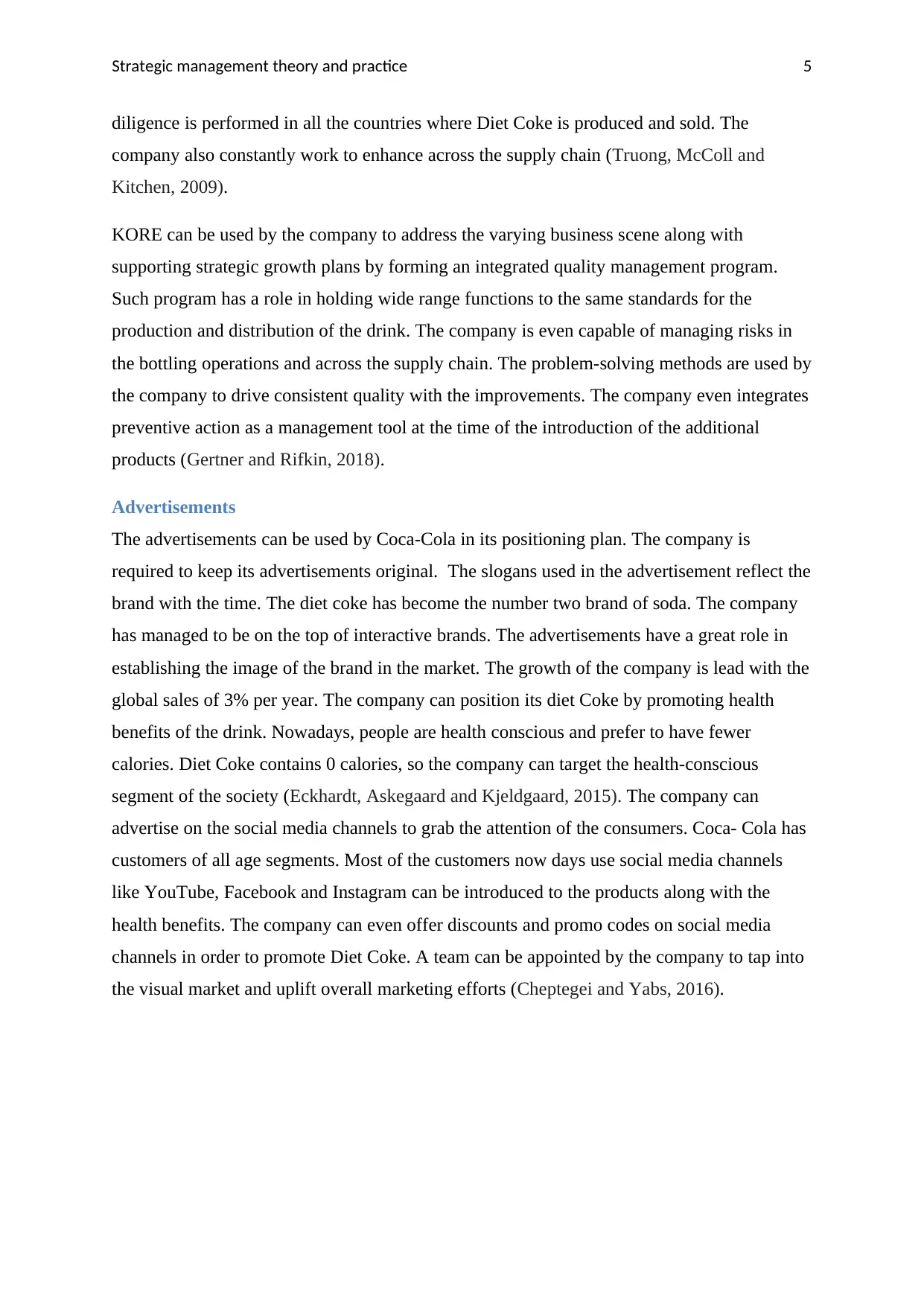
Strategic management theory and practice 5
diligence is performed in all the countries where Diet Coke is produced and sold. The
company also constantly work to enhance across the supply chain (Truong, McColl and
Kitchen, 2009).
KORE can be used by the company to address the varying business scene along with
supporting strategic growth plans by forming an integrated quality management program.
Such program has a role in holding wide range functions to the same standards for the
production and distribution of the drink. The company is even capable of managing risks in
the bottling operations and across the supply chain. The problem-solving methods are used by
the company to drive consistent quality with the improvements. The company even integrates
preventive action as a management tool at the time of the introduction of the additional
products (Gertner and Rifkin, 2018).
Advertisements
The advertisements can be used by Coca-Cola in its positioning plan. The company is
required to keep its advertisements original. The slogans used in the advertisement reflect the
brand with the time. The diet coke has become the number two brand of soda. The company
has managed to be on the top of interactive brands. The advertisements have a great role in
establishing the image of the brand in the market. The growth of the company is lead with the
global sales of 3% per year. The company can position its diet Coke by promoting health
benefits of the drink. Nowadays, people are health conscious and prefer to have fewer
calories. Diet Coke contains 0 calories, so the company can target the health-conscious
segment of the society (Eckhardt, Askegaard and Kjeldgaard, 2015). The company can
advertise on the social media channels to grab the attention of the consumers. Coca- Cola has
customers of all age segments. Most of the customers now days use social media channels
like YouTube, Facebook and Instagram can be introduced to the products along with the
health benefits. The company can even offer discounts and promo codes on social media
channels in order to promote Diet Coke. A team can be appointed by the company to tap into
the visual market and uplift overall marketing efforts (Cheptegei and Yabs, 2016).
diligence is performed in all the countries where Diet Coke is produced and sold. The
company also constantly work to enhance across the supply chain (Truong, McColl and
Kitchen, 2009).
KORE can be used by the company to address the varying business scene along with
supporting strategic growth plans by forming an integrated quality management program.
Such program has a role in holding wide range functions to the same standards for the
production and distribution of the drink. The company is even capable of managing risks in
the bottling operations and across the supply chain. The problem-solving methods are used by
the company to drive consistent quality with the improvements. The company even integrates
preventive action as a management tool at the time of the introduction of the additional
products (Gertner and Rifkin, 2018).
Advertisements
The advertisements can be used by Coca-Cola in its positioning plan. The company is
required to keep its advertisements original. The slogans used in the advertisement reflect the
brand with the time. The diet coke has become the number two brand of soda. The company
has managed to be on the top of interactive brands. The advertisements have a great role in
establishing the image of the brand in the market. The growth of the company is lead with the
global sales of 3% per year. The company can position its diet Coke by promoting health
benefits of the drink. Nowadays, people are health conscious and prefer to have fewer
calories. Diet Coke contains 0 calories, so the company can target the health-conscious
segment of the society (Eckhardt, Askegaard and Kjeldgaard, 2015). The company can
advertise on the social media channels to grab the attention of the consumers. Coca- Cola has
customers of all age segments. Most of the customers now days use social media channels
like YouTube, Facebook and Instagram can be introduced to the products along with the
health benefits. The company can even offer discounts and promo codes on social media
channels in order to promote Diet Coke. A team can be appointed by the company to tap into
the visual market and uplift overall marketing efforts (Cheptegei and Yabs, 2016).

Strategic management theory and practice 6
Diet Coke contains low sugar and is the traditional product. It is having several competitors
like Diet Pepsi, Pepsi Max, Coke Zero, Coke Classic, Pepsi and Pepsi Next. Coca-Cola does
not comprise when it comes to the nutrition and health benefits. The company offers low
sugar taste like a traditional drink. As the map represents Diet Coke is the only product which
contains low sugar taste. The customers prefer to consume Diet Coke as it contains zero
calories.
Specific strategy
Coca-Cola is a major soft drink company. It operates in over 200 countries around the globe.
The company has strong brand recognition worldwide. The company follows strategies to sell
the products and remain competitive in the market. The specific strategy to be used by the
company for Diet Coke is:
Content and social media marketing
Diet Coke contains low sugar and is the traditional product. It is having several competitors
like Diet Pepsi, Pepsi Max, Coke Zero, Coke Classic, Pepsi and Pepsi Next. Coca-Cola does
not comprise when it comes to the nutrition and health benefits. The company offers low
sugar taste like a traditional drink. As the map represents Diet Coke is the only product which
contains low sugar taste. The customers prefer to consume Diet Coke as it contains zero
calories.
Specific strategy
Coca-Cola is a major soft drink company. It operates in over 200 countries around the globe.
The company has strong brand recognition worldwide. The company follows strategies to sell
the products and remain competitive in the market. The specific strategy to be used by the
company for Diet Coke is:
Content and social media marketing
Paraphrase This Document
Need a fresh take? Get an instant paraphrase of this document with our AI Paraphraser
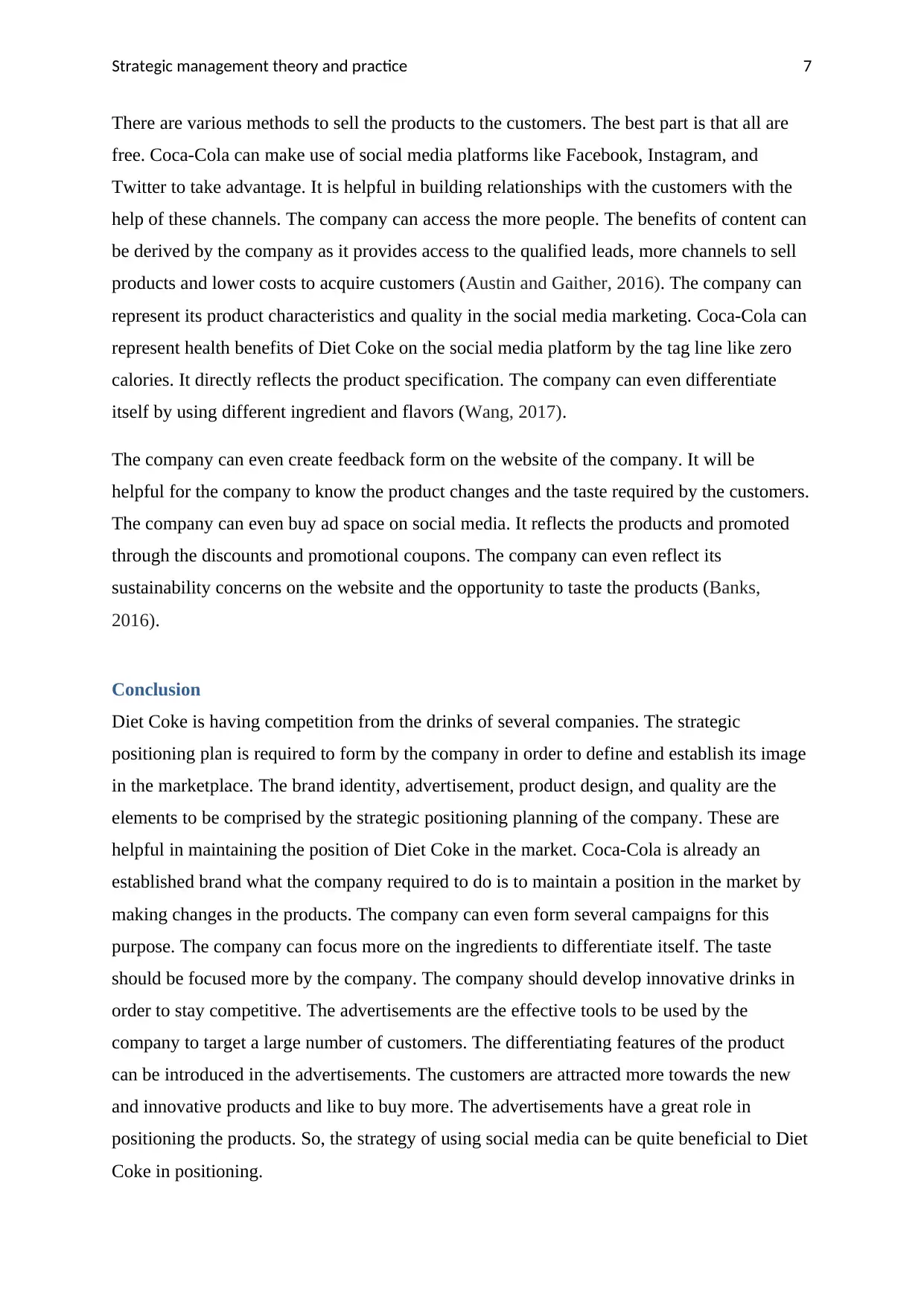
Strategic management theory and practice 7
There are various methods to sell the products to the customers. The best part is that all are
free. Coca-Cola can make use of social media platforms like Facebook, Instagram, and
Twitter to take advantage. It is helpful in building relationships with the customers with the
help of these channels. The company can access the more people. The benefits of content can
be derived by the company as it provides access to the qualified leads, more channels to sell
products and lower costs to acquire customers (Austin and Gaither, 2016). The company can
represent its product characteristics and quality in the social media marketing. Coca-Cola can
represent health benefits of Diet Coke on the social media platform by the tag line like zero
calories. It directly reflects the product specification. The company can even differentiate
itself by using different ingredient and flavors (Wang, 2017).
The company can even create feedback form on the website of the company. It will be
helpful for the company to know the product changes and the taste required by the customers.
The company can even buy ad space on social media. It reflects the products and promoted
through the discounts and promotional coupons. The company can even reflect its
sustainability concerns on the website and the opportunity to taste the products (Banks,
2016).
Conclusion
Diet Coke is having competition from the drinks of several companies. The strategic
positioning plan is required to form by the company in order to define and establish its image
in the marketplace. The brand identity, advertisement, product design, and quality are the
elements to be comprised by the strategic positioning planning of the company. These are
helpful in maintaining the position of Diet Coke in the market. Coca-Cola is already an
established brand what the company required to do is to maintain a position in the market by
making changes in the products. The company can even form several campaigns for this
purpose. The company can focus more on the ingredients to differentiate itself. The taste
should be focused more by the company. The company should develop innovative drinks in
order to stay competitive. The advertisements are the effective tools to be used by the
company to target a large number of customers. The differentiating features of the product
can be introduced in the advertisements. The customers are attracted more towards the new
and innovative products and like to buy more. The advertisements have a great role in
positioning the products. So, the strategy of using social media can be quite beneficial to Diet
Coke in positioning.
There are various methods to sell the products to the customers. The best part is that all are
free. Coca-Cola can make use of social media platforms like Facebook, Instagram, and
Twitter to take advantage. It is helpful in building relationships with the customers with the
help of these channels. The company can access the more people. The benefits of content can
be derived by the company as it provides access to the qualified leads, more channels to sell
products and lower costs to acquire customers (Austin and Gaither, 2016). The company can
represent its product characteristics and quality in the social media marketing. Coca-Cola can
represent health benefits of Diet Coke on the social media platform by the tag line like zero
calories. It directly reflects the product specification. The company can even differentiate
itself by using different ingredient and flavors (Wang, 2017).
The company can even create feedback form on the website of the company. It will be
helpful for the company to know the product changes and the taste required by the customers.
The company can even buy ad space on social media. It reflects the products and promoted
through the discounts and promotional coupons. The company can even reflect its
sustainability concerns on the website and the opportunity to taste the products (Banks,
2016).
Conclusion
Diet Coke is having competition from the drinks of several companies. The strategic
positioning plan is required to form by the company in order to define and establish its image
in the marketplace. The brand identity, advertisement, product design, and quality are the
elements to be comprised by the strategic positioning planning of the company. These are
helpful in maintaining the position of Diet Coke in the market. Coca-Cola is already an
established brand what the company required to do is to maintain a position in the market by
making changes in the products. The company can even form several campaigns for this
purpose. The company can focus more on the ingredients to differentiate itself. The taste
should be focused more by the company. The company should develop innovative drinks in
order to stay competitive. The advertisements are the effective tools to be used by the
company to target a large number of customers. The differentiating features of the product
can be introduced in the advertisements. The customers are attracted more towards the new
and innovative products and like to buy more. The advertisements have a great role in
positioning the products. So, the strategy of using social media can be quite beneficial to Diet
Coke in positioning.
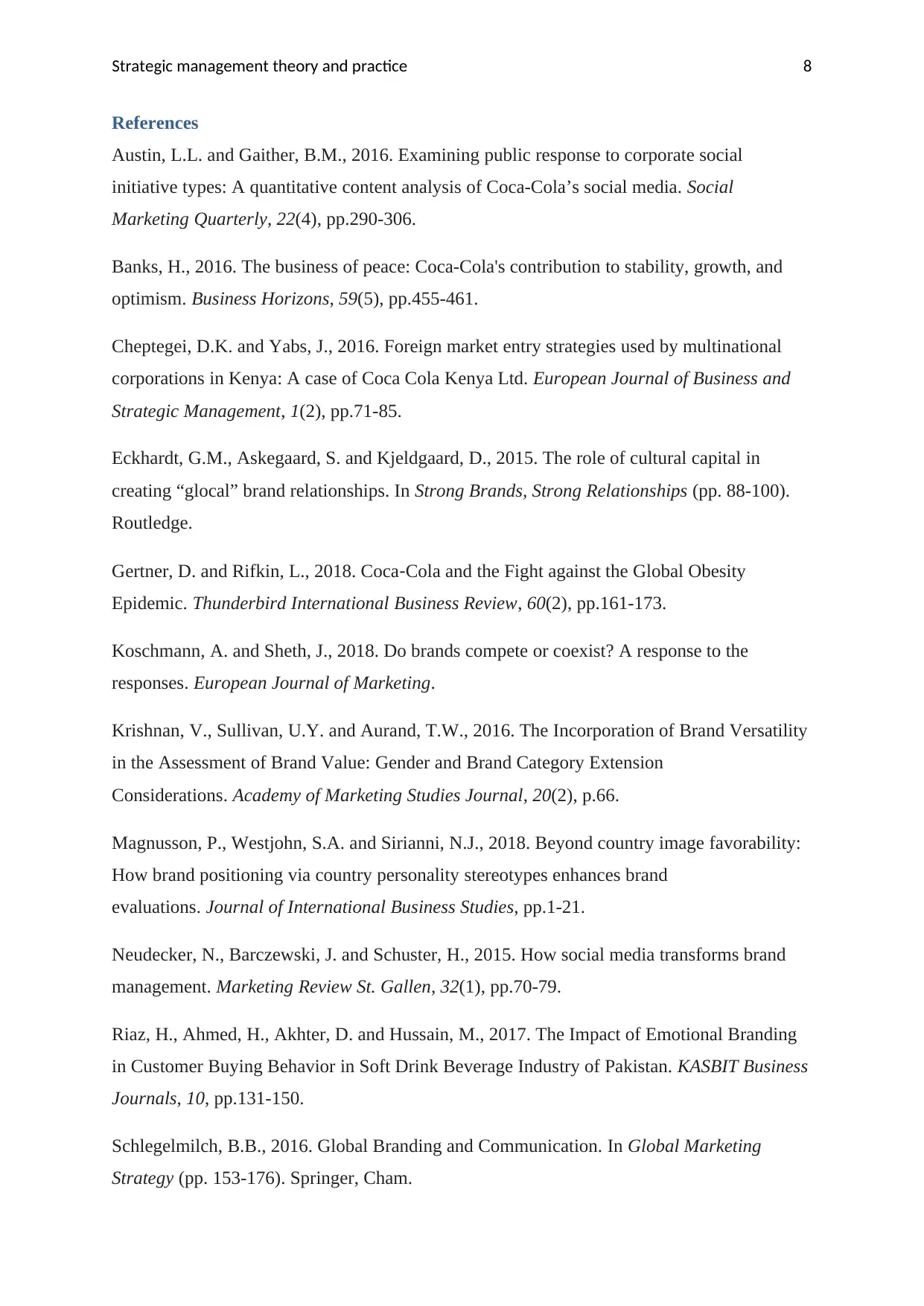
Strategic management theory and practice 8
References
Austin, L.L. and Gaither, B.M., 2016. Examining public response to corporate social
initiative types: A quantitative content analysis of Coca-Cola’s social media. Social
Marketing Quarterly, 22(4), pp.290-306.
Banks, H., 2016. The business of peace: Coca-Cola's contribution to stability, growth, and
optimism. Business Horizons, 59(5), pp.455-461.
Cheptegei, D.K. and Yabs, J., 2016. Foreign market entry strategies used by multinational
corporations in Kenya: A case of Coca Cola Kenya Ltd. European Journal of Business and
Strategic Management, 1(2), pp.71-85.
Eckhardt, G.M., Askegaard, S. and Kjeldgaard, D., 2015. The role of cultural capital in
creating “glocal” brand relationships. In Strong Brands, Strong Relationships (pp. 88-100).
Routledge.
Gertner, D. and Rifkin, L., 2018. Coca‐Cola and the Fight against the Global Obesity
Epidemic. Thunderbird International Business Review, 60(2), pp.161-173.
Koschmann, A. and Sheth, J., 2018. Do brands compete or coexist? A response to the
responses. European Journal of Marketing.
Krishnan, V., Sullivan, U.Y. and Aurand, T.W., 2016. The Incorporation of Brand Versatility
in the Assessment of Brand Value: Gender and Brand Category Extension
Considerations. Academy of Marketing Studies Journal, 20(2), p.66.
Magnusson, P., Westjohn, S.A. and Sirianni, N.J., 2018. Beyond country image favorability:
How brand positioning via country personality stereotypes enhances brand
evaluations. Journal of International Business Studies, pp.1-21.
Neudecker, N., Barczewski, J. and Schuster, H., 2015. How social media transforms brand
management. Marketing Review St. Gallen, 32(1), pp.70-79.
Riaz, H., Ahmed, H., Akhter, D. and Hussain, M., 2017. The Impact of Emotional Branding
in Customer Buying Behavior in Soft Drink Beverage Industry of Pakistan. KASBIT Business
Journals, 10, pp.131-150.
Schlegelmilch, B.B., 2016. Global Branding and Communication. In Global Marketing
Strategy (pp. 153-176). Springer, Cham.
References
Austin, L.L. and Gaither, B.M., 2016. Examining public response to corporate social
initiative types: A quantitative content analysis of Coca-Cola’s social media. Social
Marketing Quarterly, 22(4), pp.290-306.
Banks, H., 2016. The business of peace: Coca-Cola's contribution to stability, growth, and
optimism. Business Horizons, 59(5), pp.455-461.
Cheptegei, D.K. and Yabs, J., 2016. Foreign market entry strategies used by multinational
corporations in Kenya: A case of Coca Cola Kenya Ltd. European Journal of Business and
Strategic Management, 1(2), pp.71-85.
Eckhardt, G.M., Askegaard, S. and Kjeldgaard, D., 2015. The role of cultural capital in
creating “glocal” brand relationships. In Strong Brands, Strong Relationships (pp. 88-100).
Routledge.
Gertner, D. and Rifkin, L., 2018. Coca‐Cola and the Fight against the Global Obesity
Epidemic. Thunderbird International Business Review, 60(2), pp.161-173.
Koschmann, A. and Sheth, J., 2018. Do brands compete or coexist? A response to the
responses. European Journal of Marketing.
Krishnan, V., Sullivan, U.Y. and Aurand, T.W., 2016. The Incorporation of Brand Versatility
in the Assessment of Brand Value: Gender and Brand Category Extension
Considerations. Academy of Marketing Studies Journal, 20(2), p.66.
Magnusson, P., Westjohn, S.A. and Sirianni, N.J., 2018. Beyond country image favorability:
How brand positioning via country personality stereotypes enhances brand
evaluations. Journal of International Business Studies, pp.1-21.
Neudecker, N., Barczewski, J. and Schuster, H., 2015. How social media transforms brand
management. Marketing Review St. Gallen, 32(1), pp.70-79.
Riaz, H., Ahmed, H., Akhter, D. and Hussain, M., 2017. The Impact of Emotional Branding
in Customer Buying Behavior in Soft Drink Beverage Industry of Pakistan. KASBIT Business
Journals, 10, pp.131-150.
Schlegelmilch, B.B., 2016. Global Branding and Communication. In Global Marketing
Strategy (pp. 153-176). Springer, Cham.
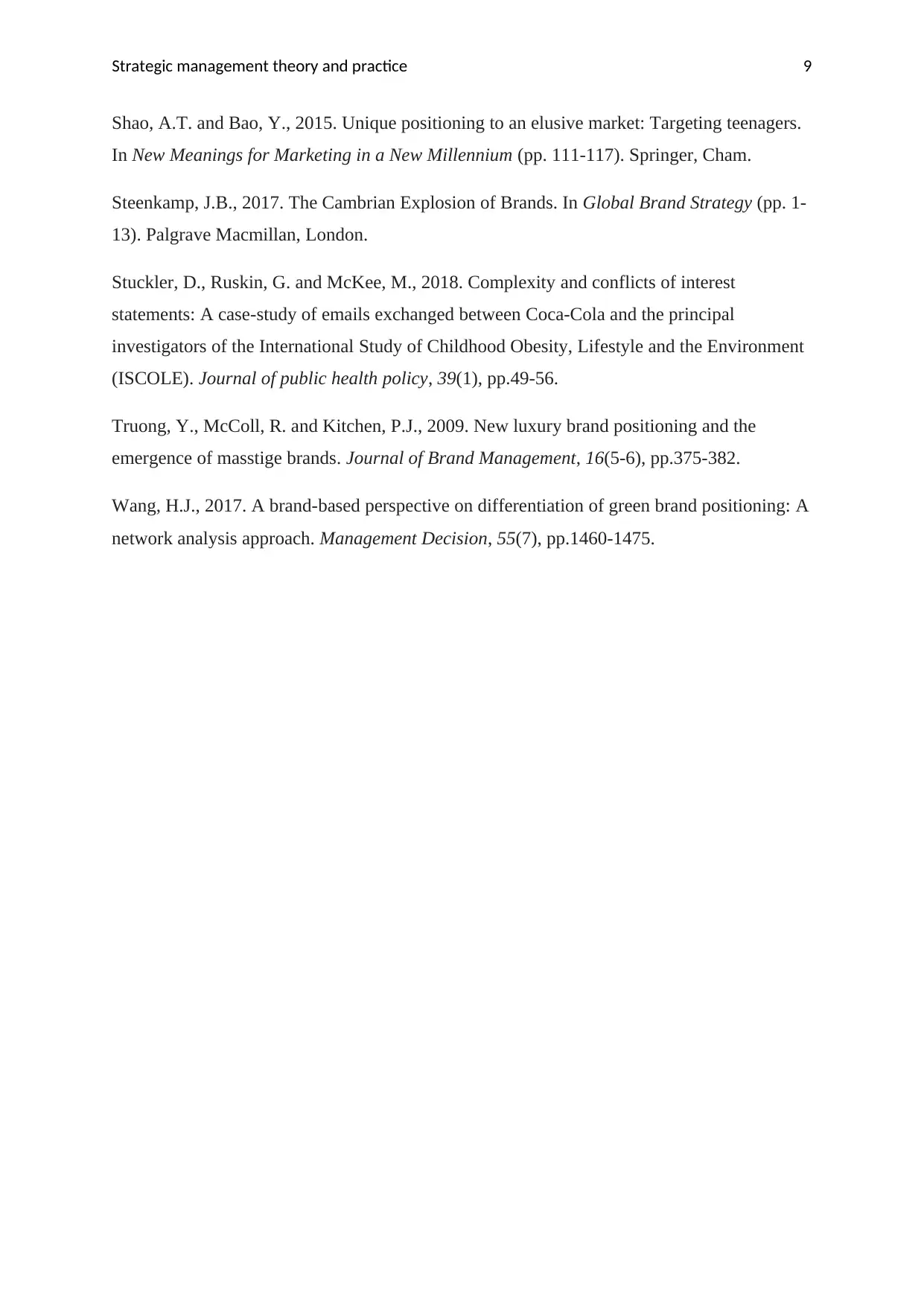
Strategic management theory and practice 9
Shao, A.T. and Bao, Y., 2015. Unique positioning to an elusive market: Targeting teenagers.
In New Meanings for Marketing in a New Millennium (pp. 111-117). Springer, Cham.
Steenkamp, J.B., 2017. The Cambrian Explosion of Brands. In Global Brand Strategy (pp. 1-
13). Palgrave Macmillan, London.
Stuckler, D., Ruskin, G. and McKee, M., 2018. Complexity and conflicts of interest
statements: A case-study of emails exchanged between Coca-Cola and the principal
investigators of the International Study of Childhood Obesity, Lifestyle and the Environment
(ISCOLE). Journal of public health policy, 39(1), pp.49-56.
Truong, Y., McColl, R. and Kitchen, P.J., 2009. New luxury brand positioning and the
emergence of masstige brands. Journal of Brand Management, 16(5-6), pp.375-382.
Wang, H.J., 2017. A brand-based perspective on differentiation of green brand positioning: A
network analysis approach. Management Decision, 55(7), pp.1460-1475.
Shao, A.T. and Bao, Y., 2015. Unique positioning to an elusive market: Targeting teenagers.
In New Meanings for Marketing in a New Millennium (pp. 111-117). Springer, Cham.
Steenkamp, J.B., 2017. The Cambrian Explosion of Brands. In Global Brand Strategy (pp. 1-
13). Palgrave Macmillan, London.
Stuckler, D., Ruskin, G. and McKee, M., 2018. Complexity and conflicts of interest
statements: A case-study of emails exchanged between Coca-Cola and the principal
investigators of the International Study of Childhood Obesity, Lifestyle and the Environment
(ISCOLE). Journal of public health policy, 39(1), pp.49-56.
Truong, Y., McColl, R. and Kitchen, P.J., 2009. New luxury brand positioning and the
emergence of masstige brands. Journal of Brand Management, 16(5-6), pp.375-382.
Wang, H.J., 2017. A brand-based perspective on differentiation of green brand positioning: A
network analysis approach. Management Decision, 55(7), pp.1460-1475.
1 out of 10
Related Documents
Your All-in-One AI-Powered Toolkit for Academic Success.
+13062052269
info@desklib.com
Available 24*7 on WhatsApp / Email
![[object Object]](/_next/static/media/star-bottom.7253800d.svg)
Unlock your academic potential
© 2024 | Zucol Services PVT LTD | All rights reserved.





